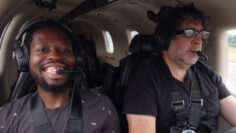Learning to Fly: An Introduction to Flight School

Has your heart ever fluttered at the thought of soaring like a bird, controlling a mighty machine that defies gravity? Have you ever closed your eyes and imagined the palpable excitement of a take-off, or the tranquil serenity of cruising above the clouds? If these dreams set your soul alight, then flight school is the first checkpoint on your exciting journey to turning them into reality.
Flight schools are the bedrock that mold dreamers into pilots, imparting not just theoretical knowledge, but practical experience to safely command an aircraft. Regardless of whether you wish to float in the sky for pleasure or aim to carve a career in aviation, flight school serves as your launchpad.

By joining a flight school, you get the chance to drink deep from the well of aviation knowledge. It’s a place where you’ll master the nuances of aerodynamics, navigation, aviation laws, and understand the secrets that lie beneath the panels of an aircraft cockpit. Here, you will not only read and learn but also take to the skies under the watchful eyes of seasoned instructors.
Taking Flight: A Look at Different Types of Flight Schools
Not all flight schools are cut from the same cloth, each comes with its unique offerings and training programs. The two key types you’d encounter on your search are Part 61 and Part 141 schools, titled after the sections of Federal Aviation Regulations (FARs) that oversee them.
A. Part 61 Flight Schools
Part 61 schools are akin to a tailor-made suit. They offer flexibility, personalized training, and operate under a more relaxed regulatory environment than Part 141 schools. If you value a custom approach to learning, focusing on your unique strengths and areas for improvement, Part 61 could be your ideal fit.
You’ll find Part 61 schools operating locally, as part of flying clubs or under independent flight instructors.
B. Part 141 Flight Schools
Part 141 schools, on the other hand, are similar to an assembly line, adhering to a structured, FAA-approved curriculum. These schools operate under strict regulatory supervision, undergoing regular audits to ensure compliance with the set standards.
If you prefer a more formal and fast-paced training regimen, Part 141 schools could be your best bet. They often have affiliations with colleges and universities, providing integrated flight programs.
You’ll commonly find Part 141 schools operating as aviation academies, university programs, and large commercial flight schools.
The Exciting Journey of Becoming a Pilot
The path to earning your wings involves crossing several exciting milestones. Let’s navigate the journey together, exploring the key stages that shape an aspiring pilot.
A. Private Pilot License (PPL)
The first milestone you’d cross is obtaining a Private Pilot License (PPL). The PPL paves the way for you to fly recreationally and undertake non-commercial flights. The training focuses on core flying skills, including aircraft control, navigation, flight planning, and understanding aviation regulations. It combines theory, practicals, and a hands-on exam.
With a PPL, you’re free to explore the skies within prescribed limitations, setting the foundation for more advanced training and endorsements.
B. Instrument Rating (IR)
The next marker on the path is the Instrument Rating (IR). This accreditation equips you to fly under instrument flight rules (IFR), allowing you to operate an aircraft by relying solely on the cockpit instruments, even in poor visibility. The IR training hones your instrument flight, navigation, and communication skills.
An IR can supercharge your flying abilities, providing the option to fly professionally or during less-than-ideal weather conditions.
C. Commercial Pilot License (CPL)
If you dream of being a professional pilot, the Commercial Pilot License (CPL) is your next stop. The CPL lets you earn from your passion, opening the gateway to a plethora of opportunities in commercial aviation, flight instruction, aerial photography, and more. The CPL training builds on your PPL training and introduces advanced flight maneuvers, emergency procedures, and commercial flight operations.
Obtaining a CPL involves additional flight hours, theory exams, practical flight tests, and meeting specific experience and skill prerequisites.
Armed with a CPL, you’re set to explore a multitude of career paths and start earning as a pilot.
Choosing the Right Flight School
Choosing a flight school isn’t merely a decision, it’s a commitment that can steer your aviation journey. Here are a few pointers to ensure you make the right choice:
A. Location and Facilities
The location of your flight school can significantly impact your training. Consider the proximity to your home, prevalent weather conditions, and access to diverse airspace. Also, take a close look at the school’s infrastructure, including the state of their aircraft, maintenance facilities, and flight simulators. An up-to-date fleet and cutting-edge simulators can make your learning experience both safe and enjoyable.
B. Reputation and Accreditation
Do your homework on the flight school’s standing and record. Look up reviews, testimonials, and success stories of past students. Reputable aviation accreditations and affiliations are good indicators of the quality of training. Don’t forget to verify the school’s credentials and their compliance with aviation norms.
C. Cost and Financing Options
Flight training can be a significant investment. Take into account tuition fees, aircraft rentals, study materials, and examination charges. Consider the financing options, such as scholarships, loans, or payment plans, offered by the school or other organizations. Knowing the total cost upfront and fitting it within your budget is a wise decision.
Flight School FAQs
FAQ 1: What are the minimum requirements to enroll in a flight school?
While specific requirements may vary depending on the flight school and the country’s aviation rules, generally, you must meet the following criteria:
- Age: You should be at least 16 years old for a glider or balloon license, and at least 17 for other aircraft categories.
- Medical Fitness: You must obtain a medical certificate from an aviation medical examiner to ensure you meet the physical fitness standards set by the aviation authority.
- Education: Typically, there are no specific educational requirements to join a flight school, although a high school diploma or equivalent is usually preferred.
- Language Proficiency: Proficiency in aviation communication, usually English, is a must to ensure effective communication with air traffic control.
FAQ 2: How long does it take to complete flight training and obtain a pilot license?
The duration of flight training varies based on the type of license and the individual’s dedication and availability for training. On average, it takes several months to a year or more to complete flight training.
To get a Private Pilot License (PPL), you usually need a minimum of 40 to 60 hours of flight time, both with an instructor and solo. How fast you can log these hours can vary based on your progress and frequency of training.
Getting an Instrument Rating (IR) takes additional time, typically ranging from a few weeks to a few months, based on the intensity of training and your availability.
Commercial Pilot License (CPL) training, being more advanced, can vary significantly in duration depending on the program and your prior experience.
Remember, these are estimates and can change based on individual progress, weather conditions, and other factors.
FAQ 3: Can I pursue flight training while working or attending college?
Yes, many flight schools offer flexible training schedules that can fit around your work or college hours. However, keep in mind that flying lessons, ground studies, and practice sessions need your focus and dedication. It requires effective time management to balance flight training with other responsibilities.
Talk to your flight school about your scheduling preferences to explore the best fit for your circumstances.
Conclusion
Choosing to attend flight school is your passport to turning your dream of becoming a pilot into a reality. By selecting the right flight school, you gain the required knowledge, skills, and qualifications to take on the skies and embark on an exciting aviation career. Take your time to research and weigh your options, ensuring that the flight school aligns with your aspirations. Let the sky be your canvas as you embark on this exhilarating journey!
Get Engaged Section
We hope this article has given you valuable insights into flight school and becoming a pilot. We’d love to hear from you! Do share your thoughts and experiences in the comments below. Have you attended flight school, or are you thinking of joining one? Feel free to share this post with others who may benefit from this information. Also, while you’re here, don’t forget to check out our recent article, “How Fast Do Planes Fly?” for more interesting insights into aviation.






